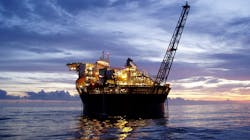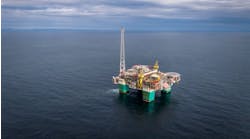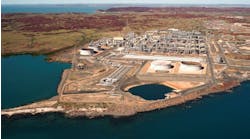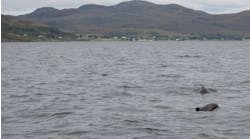Bruce Beaubouef * Managing Editor
The offshore industry is increasingly turning to FPU modification and redeployment as a means of shortening cycle time and getting to first oil faster and cheaper.
Since last December, there have been six floating units redeployed – a real “redeployment rush,” says David Boggs of the consulting firm Energy Maritime Associates. “Traditionally, about 15% of orders are fulfilled by redeployments,” Boggs said during a presentation at the recent Floating Energy Systems–Asia virtual event hosted by Offshore and Endeavor Business Media. The six units redeployed or assigned for redeployment in the last six months is “higher than I can ever recall.”
There are several drivers of this “redeployment rush,” Boggs says. They include:
- Shorter time to first oil (~6-12 months versus much longer conversion timetables)
- Potentially less expensive, but this depends on the condition of the FPU and upgrades required
- Purchase price “as-is” typically runs from $10 to $80 million, with upgrades costing 5-10 times more
- Lower carbon emissions (~70% reduction as compared to new construction).
Boggs also noted that most of these redeployed FPUs “tend to be smaller” – with a 50,000 barrel per day production rate, or less. “So it is a niche market, with the FPUs tending to be designated either for redevelopment of marginal fields that have been shut down in the past, or as early production systems.” The Firenze FPSO, formerly deployed in the southern Adriatic Sea, is one such example. “Eni is using that FPU as an early production system to test the reservoir on the Baleine field off the Ivory Coast. They will use that facility for a couple of years, then bring in a larger unit.”
And it is a trend that is expected to continue. There are currently 36 idle production units, including 23 FPSOs, Boggs says. “There’s still a large number of units available, and we’ve gone through and done an extensive analysis of these units, and we expect that at least eight of these have a high chance of being re-used. These are units that were built to higher specifications, and most of these are already in negotiation for redeployment. There are 11 units that are very old assets, and these will be recycled. Then there are 17 units that are ‘in the middle’ that could go either way, depending on timing. Nine units came off contract in 2020 when oil prices crashed, and then six more became available in 2021, and an additional three have become available this year. As a result, many units are now available for redeployment, and five units have been redeployed so far in 2022.”
Some of the key FPU redeployments being planned are outlined below.
Nganhurra redeployment
Operator bp has elected to redeploy the FPSO Nganhurra for its PAJ project offshore Angola. Yinson Holdings Berhad, through its subsidiary Yinson Acacia Ltd., recently entered into an agreement with bp Exploration (Angola) Ltd., as the operator of the Block 31 contractor group, for the reservation of the Nganhurra, for use in bp’s proposed 10-well subsea Palas, Astrea and Juno (PAJ) oil field development project.
Under the agreement, Yinson will exclusively allocate FPSO Nganhurra to bp for the PAJ project until Dec. 31, with an option for bp to extend until June 30, 2023, while the parties negotiate a contract to convert, operate, maintain and lease the FPSO for the PAJ project. The lease and operate contract, which is anticipated to include a 10-year fixed term, is expected to be executed by the end of 2024, subsequent to bp reaching final investment decision.
The FPSO Nganhurra has a production capacity of 100,000 bbl/d of oil and was built by Samsung in 2006. The FPSO, which operated at the Enfield field in Australia until autumn 2018, is laid up outside Labuan, Malaysia.
Yinson holds an exclusive purchase option for FPSO Nganhurra until June 30, 2023, with its owners, Woodside Energy and Mitsui E&P Australia Pty Ltd, with an option for Yinson to extend such exclusive purchase option until Dec. 31, 2023.
OSX-2 redeployment
Earlier this year, Brazilian oil company Enauta completed the purchase of the FPSO OSX-2, which it plans to redeploy for the development of its Atlanta oil field in the Santos Basin, offshore Brazil. Enauta CEO Décio Oddone says that the negotiated terms allow the project to have “a low breakeven and attractive returns.”
Enauta engaged in a detailed review of the proposed field development after the withdrawal of former partner Barra Energia. The review resulted in a decision to go ahead with the full-scale development, but only after streamlining the economics—including the redeployment of an existing FPU. Enauta said its updated development plan will increase the economic resilience of the project due to a “significant reduction” in capital expenditure.
The OSX 2 FPSO was built in 2013 and went from the shipyard to storage site when the field operator (OGX) decided to not deploy the production unit. The FPU is reported to have been warm-stacked near Karimunbesar Island in the Singapore Strait since 2015, following the collapse of OGX, which had been part the Brazilian conglomerate EBX.
Enauta has issued a letter of intent to Yinson for the adaptation of the OSX-2 through a turnkey EPCI contract. Acquisition and adaptation cost is expected to be around $500 million. From the letter, Yinson would, prior to the startup of production from the FPSO, have the option to purchase the unit linked to financing. If the option is exercised, it will be linked to charter, operation, and maintenance contracts for a period of 15 years, which may be extended for another five years, totaling $2 billion for the 20 years.
Enauta has already used an early production system on Atlanta which features the Petrojarl I FPSO, which has been connected to three wells there. The OSX 2 will be connected to between six and eight horizontal production wells, including the three currently being serviced by the Petrojarl I, and the OSX-2 is expected to be able to process 50,000 bbl/day of heavy crude starting in 2024.
Firenze redeployment
Eni says that it is planning for early production from last year’s deepwater Baleine discovery off the Ivory Coast, and that production date is expected in late 2023. The redeployment of the Firenze FPSO will play a large role in that development. The Firenze, which is reportedly drydocked in Dubai as of this writing, had been working at the Aquila field in the southern Adriatic Sea. Baleine is expected to be a “phased fast-track development,” as defined with the local authorities, and Eni says that it will also be Africa’s first net-zero emission project (Scope 1 and 2).
Polvo redeployment
Recently the vessel ended its charter on the Polvo field, which is close to Maromba field and with similar oil and reservoir characteristics.
Maromba is in 160 m (525 ft) water depth. Nine wells were drilled on the license between 1980 and 2006, with oil proven in eight of the wells across various reservoirs. Estimated recoverable reserves are 100 MMbbl.
BW Energy is now holding talks with relevant shipyards concerning a refurbishment/life extension for the re-deployment. The company plans to modify the vessel to handle production from up to 10 wells, and 1.2 MMbbl of crude storage capacity.
Its total liquids capacity will be 85,000 b/d, with water treatment capacity of 75,000 b/d.
According to the company, the agreement to purchase the FPSO, instead of entering a traditional lease and operate contract, is due in part to Brazilian tax legislation issues.
The company plans a phased subsea development with an initial three horizontal wells on Maromba, leading to first oil in 2025. A second three (horizontal) well campaign would follow in 2027: the investment decision remains subject to completion of project financing, although Brazilian regulator ANP has approved the development plan.
“We know the vessel well and have extensive in-house competencies and capabilities in planning and executing such a repair and life extension project,” said BW Energy CEO Carl K. Arnet. “Re-using existing energy infrastructure enables reduced investments, shorter time to first oil and significantly reduced CO2 emissions in the development phase as compared to installing new production assets.”
In addition to the redeployed vessel, the subsea layout is also designed to keep down costs and facilitate future expansions. Total oil production at peak is expected to be between 30-40,000 bbl/day.
Petrojarl Varg redeployment
Invenire Energy is reportedly interested in redeploying the Petrojarl Varg to its PY-3 field in the Bay of Bengal, offshore India. The FPSO was originally constructed in 1998 and went into service that same year at the Varg field offshore Norway. It then went on to produce and operate at the Varg field for 18 years, far beyond the original estimates for the field. Teekay Offshore Partners acquired the vessel in 2009, and it underwent a program of repairs, modifications and life extension works at the Sembcorp Marine yard in 2018. The vessel has been on the market since at least 2019, when Teekay terminated an agreement with Alpha Petroleum Resources to redeploy the FPSO to the Cheviot field in the UK North Sea. After that deal fell through, Teekay announced that it would seek another buyer Petrojarl Varg.
Sevan Hummingbird redeployment
Ping Petroleum UK plans to redeploy the Sevan Hummingbird FPSO for the development of its Avalon development project in the UK central North Sea. The vessel, originally built in 2007, has also been known as the Hummingbird Spirit, or just Hummingbird. For 13 years, it served as the production and storage facility at the Spirit Energy-operated Chestnut field, also in the UK central North Sea. The cylindrical FPSO, which has a hull diameter of 60 meters, has the capacity to produce up to 30,000 bbl/day of oil and a storage capacity of 270,000 barrels.
In March, Ping Petroleum received a letter of “no objections” from the UK’s North Sea Transition Authority (NSTA) in March for its proposals for Avalon. In addition, the NSTA granted a 19-month extension to the second term of the P2006 license containing the field, giving Ping the extra time it needs to optimize the development and secure full regulatory approval for its plan.
Ping Petroleum says it plans to modify the FPSO to facilitate electrification from an external, low-carbon source. It is also assessing the potential for connecting it to a dedicated floating offshore wind turbine as the power source, to minimize diesel use and associated greenhouse gas emissions.
In July, Ping Petroleum took delivery of the FPSO from Teekay Corp., and the Sevan Hummingbird has now been towed from the Chestnut field to the Port of Nigg, Cromarty Firth, for repairs and modifications. The FPSO, which will reportedly be renamed Excalibur, is expected to be fully operational on the Avalon field in 3Q 2025.
Independence Hub redeployment
LLOG Exploration Co. has announced that its Salamanca production facility will be created from the refurbishment of the Independence Hub semisubmersible platform, which was decommissioned in 2019. The refurbished FPU will serve as the collection point for production from the joint development of the Leon and Castille discoveries in Keathley Canyon in the deepwater Gulf of Mexico.
The hull, topside truss, cranes and lifeboats will be reused with minor modifications. All other topside equipment, including piping, instrumentation and electrical systems, will be new and fit for purpose. The undertaking marks the first time that an operator in the Gulf of Mexico will have refurbished and re-used an existing semisubmersible production facility, LLOG says.
The column-stabilized Salamanca FPS will be located in Keathley Canyon block 689 at a water depth of about 6,400 ft. It will feature facilities capable of processing 60,000 bbl/day of oil, 25,000 bbl/day of water, and 40 MMscf/day of natural gas.
Philip LeJeune, President and CEO of LLOG, commented: “By modifying a previously built production unit compared with constructing a new facility, we are able to reduce significantly the time and cost to bring these discoveries online.” LeJeune also noted that the FPU project will have a significant positive ESG impact, since the repurposing an existing unit is expected to reduce the emissions impact compared to the construction of a new unit by approximately 70%.
LLOG says it will obtain ABS A1 notation for the platform to comply with CG-ENG Policy Letter No. 01-13, Alternate Design and Equipment Standard for Floating Offshore Installations.
Initial production from the joint development is expected mid-2025.






